"Cherishing Little Steps - A Haven for Baby and Family Journeys"
6 Month Baby Shoes
Discover the perfect footwear for your 6-month-old with our comprehensive guide on 6-month baby shoes.
As your little one’s feet continue to develop, it’s crucial to provide them with proper support and comfort.
In this article, we’ll explore the factors to consider when choosing baby shoes, including size, materials, and features.
We’ll also recommend top brands and discuss styles for fashionable little feet.
Don’t miss out on giving your baby the best start in their journey of walking and exploring the world.
Key Takeaways
- Proper footwear supports the developing feet of 6-month-olds.
- Choosing shoes with firm soles and cushioning protects delicate feet.
- Shoes should have a proper fit and room for toe growth.
- Incorrect footwear can lead to flat feet or toe deformities.
The Importance of Proper Footwear for 6-Month-Olds
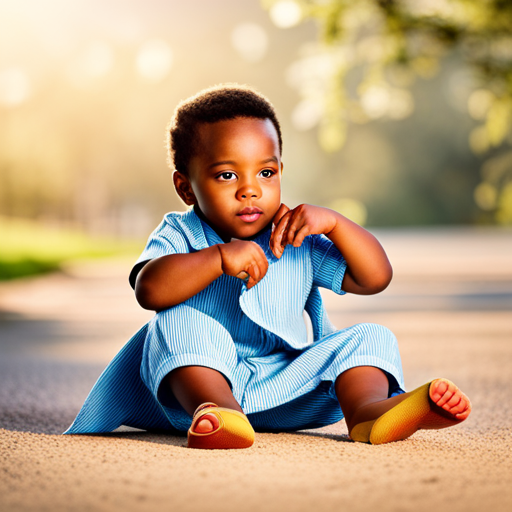
Proper footwear is crucial for 6-month-olds as it supports their developing feet and promotes healthy growth and mobility. During this stage of infancy, the bones, muscles, and ligaments in a baby’s feet are still developing, and providing them with the right footwear can significantly impact their foot development.
When choosing proper footwear for 6-month-olds, it is important to consider a few key factors. Firstly, the shoes should provide adequate support to the baby’s feet. This means ensuring that the shoes have a firm sole that offers stability and cushioning to protect their delicate feet. Additionally, the shoes should have a proper fit, with enough room for the baby’s toes to wiggle and grow. It is recommended to measure the baby’s feet regularly to ensure they are wearing the correct size.
Proper footwear also plays a vital role in promoting healthy growth and mobility. Shoes that are too tight or restrictive can hinder the natural development of the baby’s feet, leading to issues such as flat feet or toe deformities. On the other hand, shoes that are too loose can affect the baby’s balance and stability.
Understanding the Development of Baby Feet at 6 Months

Regularly monitoring and studying the development of baby feet at 6 months allows healthcare professionals to identify any potential issues and provide appropriate interventions if necessary. Understanding the milestones of foot development at this age is crucial for ensuring healthy growth and addressing any common foot problems that may arise.
At 6 months, babies have reached several important milestones in their foot development. They are typically able to bear weight on their feet while supported, and may even start to pull themselves up to a standing position. Their feet are also becoming more flexible and their arches are starting to develop.
However, it’s important to note that every baby develops at their own pace, so there may be some variations in the timeline of these milestones. Healthcare professionals should be aware of this and monitor each baby’s progress accordingly.
To better understand the development of baby feet at 6 months, the following table provides an overview of the typical milestones and potential common foot problems:
| Development Milestones | Common Foot Problems |
|---|---|
| Able to bear weight on feet while supported | Flat feet |
| Starting to pull up to a standing position | In-toeing or out-toeing |
| Increasing flexibility of feet | Ingrown toenails |
| Developing arches | Toe-walking |
Factors to Consider When Choosing Baby Shoes

When selecting baby shoes, it is essential to take into account factors such as the material, size, and flexibility to ensure optimal foot development. The feet of babies are still growing and developing, and wearing the wrong shoes can hinder their natural growth.
One of the most important factors to consider when choosing baby shoes is the material. It is recommended to opt for soft, breathable materials such as leather or cloth. These materials allow for proper air circulation and prevent the feet from sweating excessively, reducing the risk of fungal infections. Additionally, soft materials provide the necessary flexibility for the baby’s feet to move and grow naturally.
Another factor to consider is the size of the shoes. It is crucial to choose the right size to prevent discomfort and potential foot problems. Babies’ feet grow rapidly, so it is recommended to measure their feet regularly and choose shoes that provide enough room for growth. It is advised to leave about a half-inch space between the baby’s big toe and the front of the shoe.
Furthermore, flexibility is a key aspect to consider. Babies’ feet need freedom of movement to develop properly. Shoes with flexible soles allow the feet to bend and flex, mimicking barefoot walking and aiding in muscle development. Avoid shoes with stiff soles or excessive arch support, as they can impede the natural movement of the feet.
Finding the Right Size for Your 6-Month-Old’s Feet
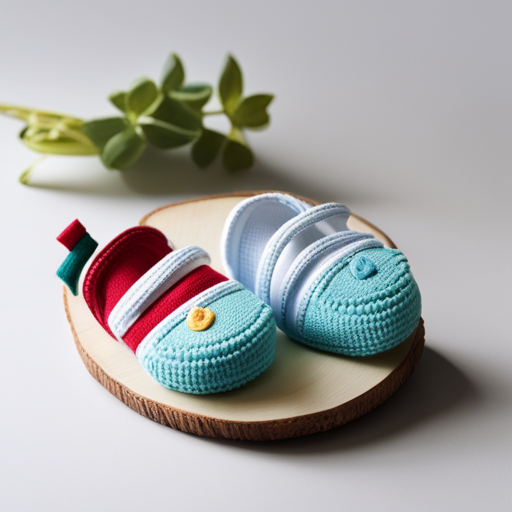
Determining the appropriate shoe size for your 6-month-old’s feet requires careful measurement and consideration of their current growth rate. Proper shoe fit is essential for the healthy development of your baby’s feet and can help prevent common foot problems in the future.
To find the right shoe size for your 6-month-old, start by measuring their feet using a soft measuring tape or a shoe-sizing device designed for infants. Measure both length and width, as a snug and comfortable fit is important. Keep in mind that babies’ feet can grow quickly, so it’s advisable to measure their feet every few months to ensure they are wearing the correct size.
Proper shoe fit is crucial in preventing common foot problems in babies, such as blisters, calluses, and ingrown toenails. Ill-fitting shoes can also lead to foot pain and discomfort, which can affect your baby’s overall well-being and mobility.
When selecting shoes for your 6-month-old, opt for soft, flexible materials that allow for natural movement of the feet. Look for shoes with a wide toe box to accommodate their growing toes and a secure closure system to keep the shoes in place.
Materials and Features to Look for in Baby Shoes

An important consideration when choosing baby shoes is the quality of materials and features that contribute to the overall comfort and development of the child’s feet. As parents, it is crucial to provide our little ones with shoes that support their growing feet and promote healthy foot development.
When it comes to baby shoe materials, it is best to opt for soft and breathable fabrics such as cotton or leather. These materials allow for proper air circulation, preventing moisture build-up and reducing the risk of skin irritations or fungal infections. Additionally, flexible soles made of rubber or suede provide better traction and allow for natural movement, supporting the development of balance and coordination skills.
In terms of features, here are some key aspects to look for in baby shoes:
| Feature | Description |
|---|---|
| Adjustable | Shoes with adjustable closures ensure a secure fit. |
| Padded | Cushioned insoles provide extra comfort and support. |
| Roomy Toe Box | Ample toe space allows for natural foot movement. |
Tips for Ensuring Comfort in Baby Shoes
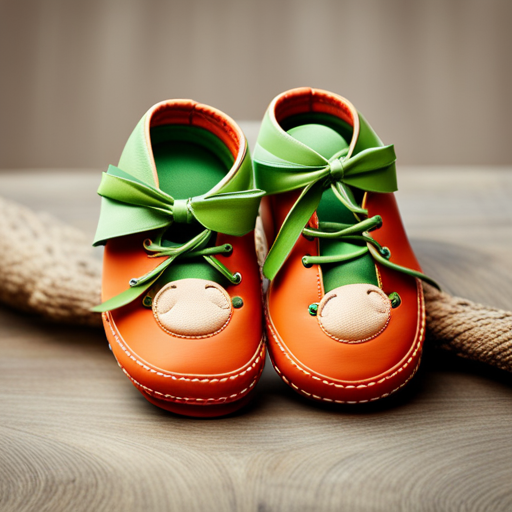
To ensure maximum comfort in baby shoes, it is important to prioritize the use of breathable materials and proper sizing. Choosing the right material for baby shoes can make a significant difference in preventing discomfort and blisters. Here are some tips for ensuring comfort in baby shoes:
-
Opt for breathable materials: Look for shoes made from natural materials like cotton or leather, as they allow proper airflow and prevent excessive sweating, which can lead to irritation and blisters.
-
Consider soft and flexible soles: Babies’ feet are still developing, so it’s important to choose shoes with soft and flexible soles that mimic the natural movement of their feet. This helps prevent discomfort and promotes healthy foot development.
-
Ensure proper sizing: Babies’ feet grow rapidly, so it’s crucial to regularly measure their feet and choose shoes that fit properly. Ill-fitting shoes can cause blisters and other foot problems. Make sure there is enough room for their toes to wiggle and for growth.
Styles and Designs for Fashionable 6-Month-Old Feet
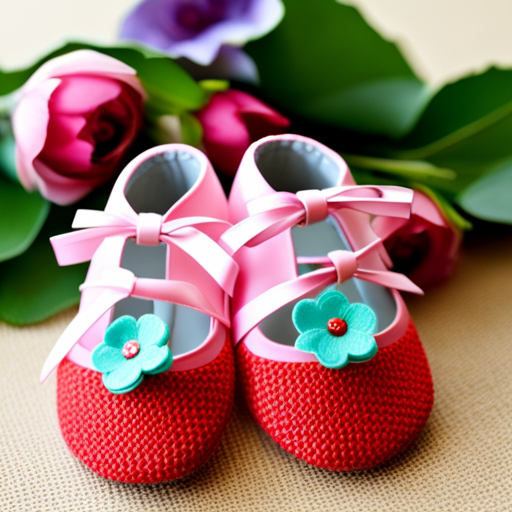
Styles and designs of baby shoes that prioritize both comfort and fashion are essential for ensuring that 6-month-old feet remain stylish and supported. As parents, we want our little ones to look cute and fashionable, but we also want to make sure their tiny feet are well taken care of. That’s why it’s important to stay updated on the latest baby shoe trends and popular colors for baby shoes.
Here is a table showcasing some of the current baby shoe trends and popular colors for 6-month-olds:
| Baby Shoe Trends | Popular Colors for Baby Shoes |
|---|---|
| Animal motifs | Soft pastels |
| Sneaker-style | Neutral tones |
| Mary Janes | Metallic shades |
| Moccasins | Bold primary colors |
| Sandals | Floral prints |
Animal motifs are a popular choice for baby shoes, adding a fun and playful touch to any outfit. Sneaker-style shoes are also on-trend, providing both comfort and style for little ones on the move. Mary Janes, with their classic and timeless design, are a great option for a more formal look. Moccasins offer a cozy and snug fit, perfect for colder months. Sandals, with their breathable and lightweight construction, are ideal for warmer weather.
When it comes to colors, soft pastels and neutral tones are popular choices for a gentle and delicate look. Metallic shades add a touch of glamour, while bold primary colors make a statement. Floral prints are also in style, adding a touch of whimsy to any outfit.
Recommended Brands for 6-Month Baby Shoes
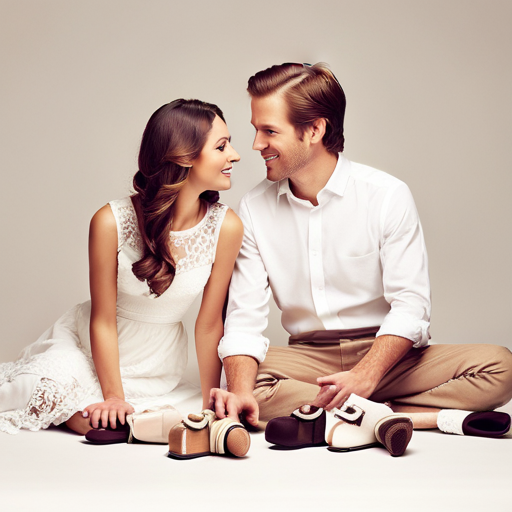
Among the recommended brands for 6-month baby shoes, Stride Rite and Robeez are known for their high-quality materials and supportive designs. These brands prioritize the comfort and safety of little feet while providing stylish options for parents. When it comes to baby shoe sizing, both Stride Rite and Robeez offer a wide range of sizes to accommodate growing feet.
Here are three reasons why Stride Rite and Robeez are popular choices for 6-month baby shoes:
-
Quality materials: Stride Rite and Robeez use premium materials such as soft leather and breathable fabrics to ensure that baby’s feet stay comfortable and protected. These materials are gentle on delicate skin and allow for natural movement.
-
Supportive designs: Both brands incorporate features like flexible soles and cushioned insoles to provide optimal support for developing feet. These designs promote proper foot development and help maintain balance while learning to walk.
-
Easy to put on and take off: Stride Rite and Robeez understand the challenges of dressing a wiggly baby. Their shoes are designed with convenient closures such as Velcro straps or elasticized openings, making it quick and easy for parents to put on and take off the shoes.
When choosing 6-month baby shoes, Stride Rite and Robeez are brands that parents can trust for quality, comfort, and style.
Best Shoes for Different Types of Activities

The selection of the best shoes for different types of activities varies depending on the specific needs and demands of each activity. When it comes to babies, choosing the right shoes for their developmental milestones is crucial.
For crawling, it is recommended to opt for soft-soled shoes that allow for maximum flexibility and natural movement. These shoes provide a good grip and protect their delicate feet from rough surfaces.
As babies progress to taking their first steps, it is important to choose shoes that provide proper support and stability. Look for shoes with a firm sole and a secure fit to aid in balance and prevent slips and falls. Additionally, shoes with a wide toe box allow for natural toe movement and development.
When selecting baby shoes, it is essential to prioritize comfort and fit over aesthetics. Avoid shoes with rigid soles or excessive padding, as they can hinder natural foot development. It is also advisable to opt for breathable materials that promote good airflow and prevent sweating and discomfort.
Caring for and Maintaining 6-Month Baby Shoes
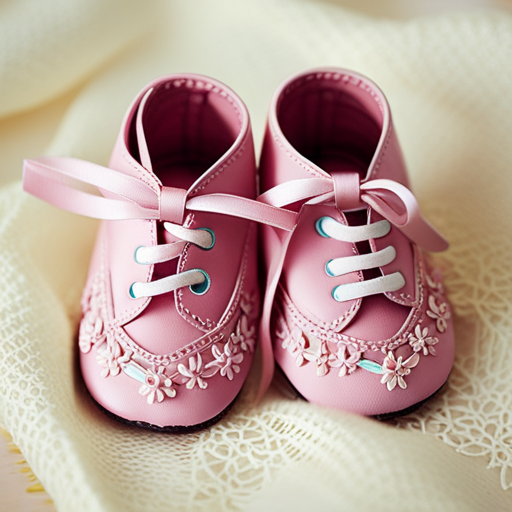
In order to ensure the longevity and quality of 6-month baby shoes, it is important for caregivers to regularly clean and store them properly. Caring for baby shoes not only helps to maintain their appearance but also ensures their functionality and comfort for the baby.
Here are some caring tips and cleaning techniques to keep baby shoes in the best condition:
-
Regularly wipe the shoes with a damp cloth to remove any dirt or stains. Avoid using harsh chemicals or abrasive materials that could damage the shoes.
-
Air dry the shoes after cleaning to prevent any moisture buildup that could lead to mold or mildew growth. Avoid direct sunlight or heat sources as they can cause discoloration or damage to the shoes.
-
Store the shoes in a cool and dry place, away from any potential hazards or contaminants. Consider using shoe bags or boxes to protect them from dust or other elements.
Frequently Asked Questions
Can I Use Regular Socks Instead of Shoes for My 6-Month-Old?
Using regular socks instead of shoes for a 6-month-old baby has both pros and cons. While socks provide comfort and flexibility, they may not offer enough protection and support for growing feet.
How Often Should I Measure My Baby’s Feet to Ensure the Right Shoe Size?
To ensure the right shoe size for your baby, it is recommended to measure their feet every 2-3 months. This frequency allows for accurate sizing as their feet grow rapidly during the first year.
Are There Any Specific Shoe Features That Promote Healthy Foot Development in Babies?
There are specific shoe features that promote healthy foot development in babies. These include using flexible materials that allow for natural movement and growth, as well as considering the different stages of foot development.
Can My 6-Month-Old Wear Hand-Me-Down Shoes From an Older Sibling?
Hand-me-down shoes can be a cost-effective option for your 6-month-old, but it’s crucial to consider the fit and condition. Consult a baby shoe size chart and ensure the shoes are still in good shape to support proper foot development.
What Should I Do if My Baby Refuses to Wear Shoes?
When a baby refuses to wear shoes, it is important to consider alternative options such as soft-soled booties or socks with grips. Dealing with shoe tantrums requires patience and understanding as the baby may be uncomfortable or simply not ready for shoes.
Conclusion
In conclusion, choosing the right footwear for 6-month-old babies is crucial for their foot development and overall comfort. Consider factors such as size, materials, and features when selecting baby shoes.
Look for reputable brands that prioritize quality and design. Different shoes are suitable for various activities, so choose accordingly.
Lastly, proper care and maintenance will ensure the longevity of the baby shoes. Remember, a well-informed choice will contribute to the well-being of your little one’s feet.


